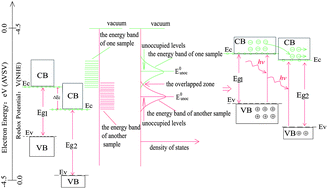Factors on the separation of photogenerated charges and the charge dynamics in oxide/ZnFe2O4 composites†
Abstract
Four oxide/ZnFe2O4 composites (WO3/ZnFe2O4, α-Bi2O3/ZnFe2O4, TiO2/ZnFe2O4 and SnO2/ZnFe2O4) were synthesized with 2 : 1, 4 : 1, 6 : 1 and 8 : 1 molar ratios of (W, Bi, Ti and Sn)/Zn. From the energy band structure, all composites can satisfy the energy level matching between their components (oxides and ZnFe2O4). For WO3/ZnFe2O4 and α-Bi2O3/ZnFe2O4, almost all of the molar ratios have stronger photovoltaic responses than each component before compounding, but the other two composites present the opposite result. Due to the different charge dynamics, the photovoltaic characteristics of four composites with molar ratio 4 : 1 did not satisfy the “inverted region effect”. Time-resolved fluorescence spectroscopy provided direct evidence of energy transfer between components. Then we discussed the factors affecting the separation of photogenerated charges and the charge dynamics from surface area, band gap, conduction band edge, energy level matching and overlapping of wave functions. The research results also provide a way to select composite systems as photoanodes for dye-sensitized solar cells.


 Please wait while we load your content...
Please wait while we load your content...